Invented by Sean Jason Keller, Tristan Thomas Trutna, Meta Platforms Technologies LLC
Fluid-based materials, such as liquid metals or conductive fluids, have unique properties that make them ideal for use in wearable devices. These materials can be easily manipulated and molded into various shapes, allowing for flexible and comfortable designs that can conform to the contours of the human body. This flexibility is particularly important for wearable devices, as they need to be comfortable to wear for extended periods of time.
In addition to their flexibility, fluid-based materials also offer excellent conductivity. This means that they can effectively transmit electrical signals, allowing for the seamless integration of circuits into wearable devices. These circuits can be used to power various functionalities, such as tracking biometric data, monitoring health parameters, or even displaying information on a screen.
One example of a wearable device that utilizes fluid-based materials and circuits is a smartwatch with a flexible display. The display is made of a thin layer of liquid metal that can be bent and twisted without damaging the screen. This allows for a more durable and resilient device that can withstand the rigors of everyday use.
Another example is a smart clothing item, such as a shirt or a jacket, that incorporates fluid-based circuits. These circuits can be used to monitor vital signs, such as heart rate or body temperature, and transmit this data to a smartphone or a cloud-based platform for analysis. This type of wearable device has the potential to revolutionize healthcare, as it can provide real-time monitoring and early detection of health issues.
The market for wearable devices with fluid-based materials and circuits is expected to grow significantly in the coming years. According to a report by MarketsandMarkets, the global market for wearable technology is projected to reach $64.03 billion by 2024, with a compound annual growth rate of 17.66% during the forecast period.
The demand for wearable devices with fluid-based materials and circuits is driven by several factors. Firstly, consumers are increasingly looking for wearable devices that are comfortable, flexible, and aesthetically pleasing. Fluid-based materials offer a unique combination of these qualities, making them highly desirable in the market.
Secondly, the healthcare industry is also a major driver of this market. The ability to monitor vital signs and collect health data in real-time has the potential to revolutionize healthcare delivery and improve patient outcomes. Wearable devices with fluid-based materials and circuits can play a crucial role in this transformation.
Lastly, advancements in technology and manufacturing processes have made it easier and more cost-effective to produce wearable devices with fluid-based materials and circuits. This has led to increased adoption and market penetration, making these devices more accessible to a wider range of consumers.
In conclusion, the market for wearable devices with fluid-based materials and circuits is poised for significant growth in the coming years. The unique properties of fluid-based materials, such as flexibility and conductivity, make them ideal for use in wearable devices. As consumer demand for comfortable and functional wearable technology continues to rise, the market for these innovative devices is expected to expand rapidly. Additionally, the healthcare industry’s interest in real-time monitoring and data collection further fuels the growth of this market. With advancements in technology and manufacturing processes, wearable devices with fluid-based materials and circuits are becoming increasingly accessible and affordable, making them a promising area of investment and innovation.
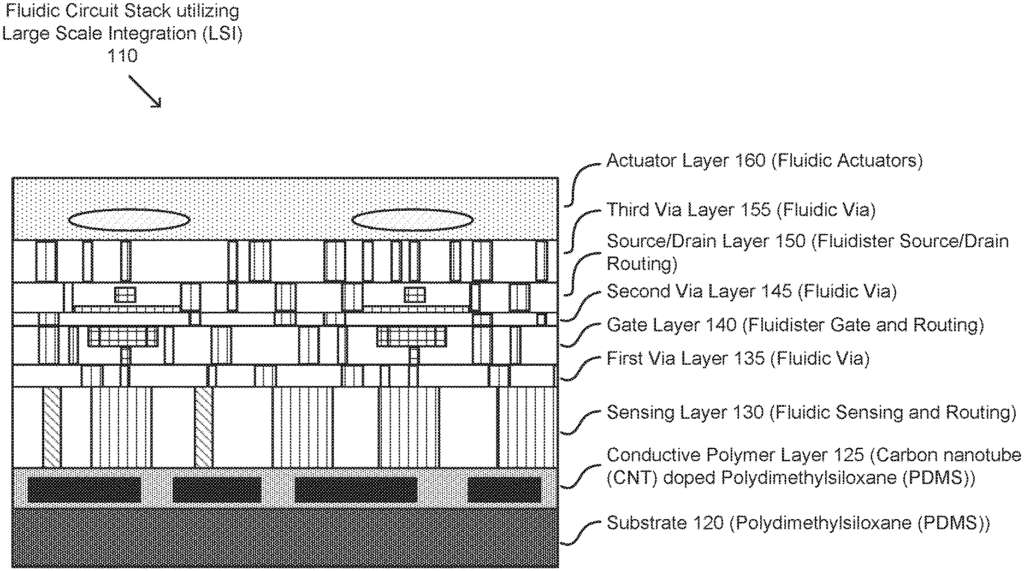
The Meta Platforms Technologies LLC invention works as follows
A method of large-scale integration of haptic device is described. The method consists of forming a liquid-based fluid circuits in a first elastomer on a substrate, according to a manufacturing process specified, and adhering the first elastomer to a number of formation specifications. The method also includes curing the first layer of elastomer. The LSI device may also include one or two additional elastomer sheets formed in conjunction with the first elastomer sheet according to the specified manufacturing procedure, each of which has a plurality fluid based circuits.
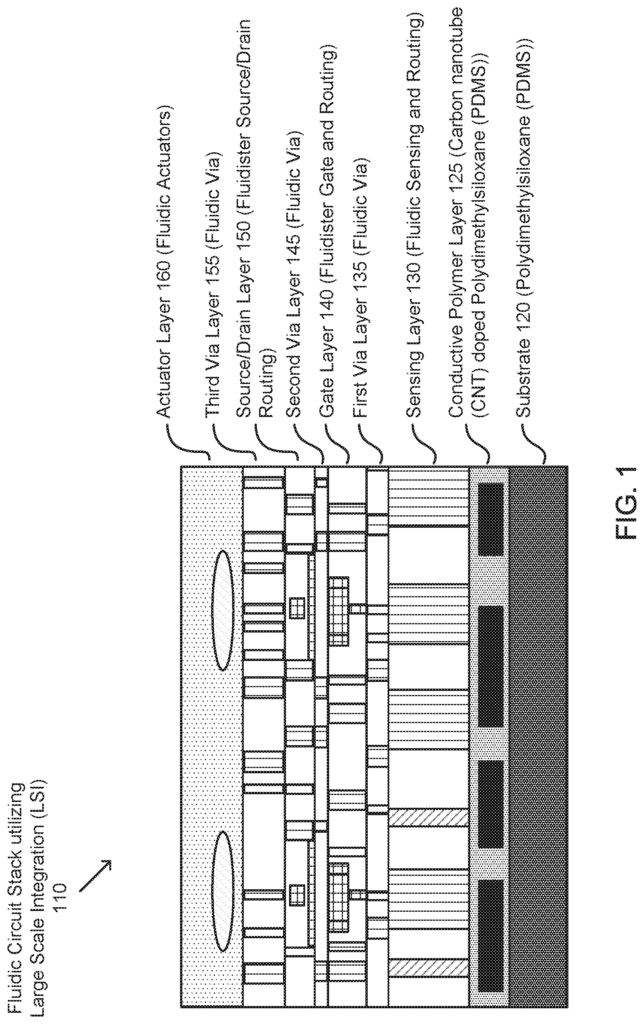
Background for Wearable device with fluid-based materials and circuits, and systems that include the wearable device in conjunction with a VR headset
The present disclosure generally relates to fluidically-controlled haptic devices for virtual reality (VR) systems and more specifically to integrating a plurality of fluidic haptic devices together with electrical and electronic devices in VR systems using large scale integration.
Virtual reality (VR), augmented or mixed reality (MR), are simulated environments created by computer technology that can be presented to a person, for example through a VR-system. Wearable devices, such as gloves, allow users to interact with virtual items in some VR systems. The circuitry of such wearable devices may be bulky and/or heavy as they can include sensors, actuators, and other devices that enhance the tactile, kinesthetic and other experiences the wearable device provides to the user. Wearable devices may be restricted by their physical size, thermal dissipation, power distribution and/or energy storage limitations. Wearable devices that are conventional can reduce the user’s VR experience.
Embodiments” describe a large-scale integration (LSI), device that is formed in accordance with various formation specifications, and using a specific manufacturing process. The LSI device can include fluidic and not-fluidic devices, and it may be used in a VR/AR/MR system. The LSI device, for example, may be used as part of the control and sensing components of a haptic gloves, and may include layers of fluidic or non-fluidic circuts. These layers can be made of polymer or fabric, and may include channels that allow fluid to flow and other fluidic components.
The LSI device can achieve high efficiency and compactness by using the design rules.” By adhering to the various design goals, it is possible to realize multiple benefits. Fluid actuation allows for high force density with minimal thermal dissipation, compared to alternative systems. The large-scale integration topology, design rules, and control system address and allow for a large number of devices to be controlled (e.g. fluid, electronic and other devices). A soft polymer implementation allows mass production.
These design rules can include, for example, the minimum and maximum operating voltages and pressures, the minimum and maximum layer thicknesses of LSI devices, the minimum hardness level, maximum signal propagation delays, thermal design requirements and so on. The LSI device can be produced using a variety of highly scalable methods, including lost wax casting and roll-to-roll manufacturing techniques, high speed stenciling and screen printing, curing agents and more.
This first layer is cured, and one or more additional elastomer layers of the LSI are formed with the first elastomer according to the specified manufacturing process. The one or more additional elastomer layers have a number of fluid based (and electronic circuits) circuits. The first layer is cured and then one or several additional elastomer LSI devices are formed using the first elastomer according to a specified manufacturing process.
In one embodiment, an LSI device comprises a first polymer layer. The LSI device includes a second layer of a polymer substrate. This layer is an elastomer with channels that allow fluid-based routing and sensing circuits to be operated in addition electrically resistive or capacitive sensing. On the surface of the sensor layer is a first via layer. The first via layer comprises an elastomer with channels for fluid-based interconnects fluidically coupled to the one or more circuits in the sensing layers. This layer can also contain electrically-conductive vias. A gate layer is also disposed on the surface of the 1st via layer. The gate layer is an elastomer with channels for fluid-based routing and gate circuits, which are fluidically connected to one or more circuits in the 1st via layer. A second via is also disposed on the surface of the first via layer. The second via layer is an elastomer with channels for fluid-based interconnects, which are fluidically connected to one or several fluid-based circuits in the gate layer. A source and a drain layer are disposed on the second via layers. The source and the drain layer are an elastomer with channels for the operation fluid-based source-and-drain circuits fluidically coupled to the one or more circuits in the second via layers.
Furthermore a third via is disposed on the surface of the gate layers, the third via being an elastomer with channels for the operation fluid-based interconnects which are fluidically coupled to the one or more circuits fluid-based of the source and the drain layer.” Finaly, an actuator is placed on the surface of the gate. The actuator layer consists of an elastomer with channels for fluid-based actuators fluidically coupled to the circuits in the third via layer.
Thus embodiments of this disclosure comprise LSI Design Rules, and manufacturing processes, to create devices such as a Fluidic Circuit Stack for Control, Sensing, and Actuation, in applications for Virtual Reality, Augmented Reality, and Mixed Reality (VR, AR, MR).
Overview
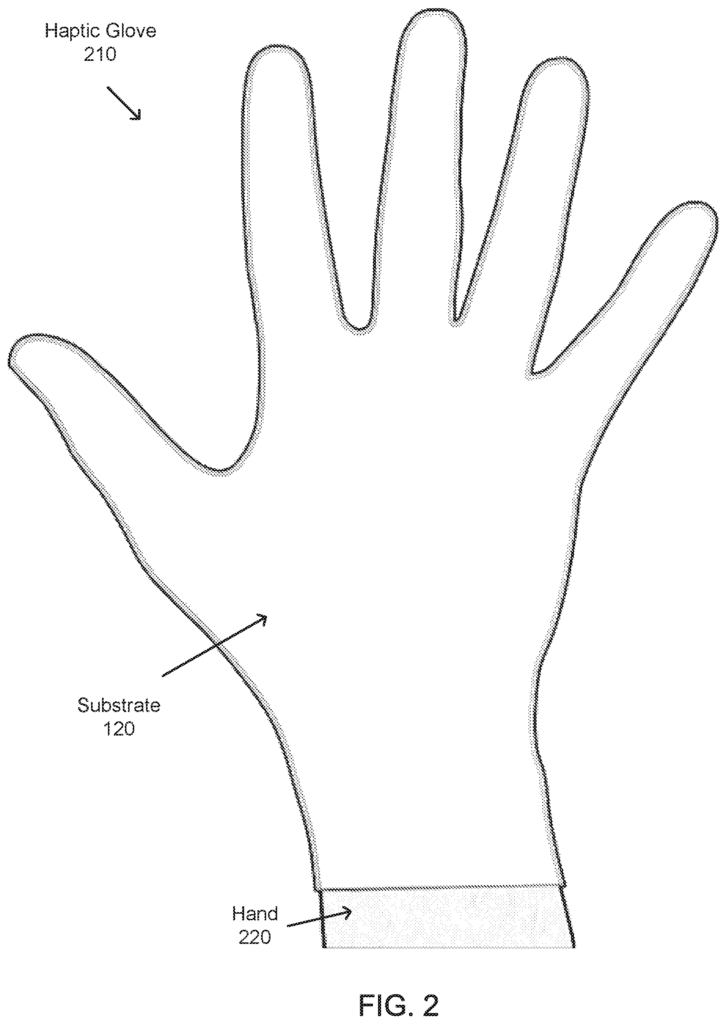
Embodiments” include large-scale integration of haptic device, which can be used in VR systems, such as pure virtual reality system (VR), an augmented reality system (AR), a mixed reality system (MR), or some combination. These haptic device may be magnetic or electrical. Fluidic devices, which handle fluids, are similar to electronic devices. A fluidic device, for example, may be designed to operate as a liquidic transistor, that is, a transistor which handles fluids instead of electrical signals. A fluidic circuit formed by a combination of fluidic devices can be used as controllers, actuators and sensors in a haptic system, such as in a glove. A combination of fluidic devices can, for example, limit or enhance a user’s movements in response to virtual inputs in the VR system. It may occur, for instance, when the user interacts in the VR environment with a solid virtual item that would restrict movement in the real world, such as the hand. This haptic device can be coupled with the VR system and use a combination of fluidic devices in order to simulate the restriction of the user’s movement. These fluidic devices may also be coupled with non-fluidic (electrical and electronic) devices such as sensors and controllers to create a combined fluidic-non-fluidic haptic device, such as an haptic glove in a VR System.
It may be difficult to build a complete haptic system by assembling and driving every actuator or sensor separately. It may be difficult to place a combination haptic devices such as sensors, actuators and control systems on a system. The combination of haptic device elements could be heavy or difficult to implement on a small surface. A haptic system that is implemented by combining haptic devices may also be difficult to scale. Combining and integrating individual fluidic devices can also be less reliable or unreliable than a systematic integration. For this problem, fluidic circuits can be stacked in layers using large scale integration.
By using LSI, fluidic and nonfluidic circuits can be layered in various ways. The resulting circuit has a smaller size and meets the dimensional or weight requirements for haptic devices. By compacting fluidic and other circuits in a smaller space, the stacking of components can also reduce manufacturing costs. Miniaturization via LSI of fluidic circuits can reduce the need for fluid pumps and channels. The fluid channels’ pressure may be reduced, which may reduce the risk of fluid leakage. The fluidic circuit may be quieter as smaller channels create less turbulence. “The LSI of fluidic circuits allows more complex fluidic circuits that can be attached to a haptic device or other VR devices to perform desired operations.
The large-scale integration of circuits, including electronic, electromechanical and fluidic, is a major advantage over traditional designs. allows for multiple advantages over traditional designs. LSI comprises design rules, constraints on manufacturing processes, and other conditions to enable the integration of different components into a system to achieve specific goals. For example, optimizing components to fit in a small space in order to provide physical forces in a VR/AR/MR environments, e.g. in a haptic gloves application. The invention does not limit itself to a specific implementation of a liquidic circuit stack. Instead, it includes design rules, manufacturing restrictions, and other conditions that create an ecosystem in which products such as the fluidic stack described herein can be created. Below are additional details about the LSI fluidic circuits.
Exemplary design rules for large scale integration
As noted above, large-scale integration (LSI), of fluid and nonfluid circuits, may adhere to various design rules, in order for various circuits and component types that meet the LSI goals, as described above. Here is an example of a set of design guidelines. These design goals are not intended to be limiting. In other embodiments the LSI could include more or less design rules, or even different ones.
Examples of design rules can relate to 1) feature sizes, 2) operating voltages/pressures, 3) layers dimensions, 4) propagation delays, 5) thermal requirements, and 6) other global constraints. In some embodiments alternate or additional design rules can be included in a LSI.
The size of the component features may be restricted to meet other system requirements such as operating pressures and thermal design requirements. In the LSI design, a maximum requirement for fluidic channels or other connections may be implemented to minimize the component size while still allowing the operating pressure to be met without, for instance, a large, bulky pump. In one embodiment, design rules specify a minimum and maximum pitch (e.g. 1 mm-5mm). Other components may be subject to the same size requirements, including maximum component sizes (e.g. 1 cm), maximum fluid volumes (e.g. 1 ml), etc.
The design rules may limit the operating pressures and voltages for a component or system designed by LSI. It may be possible to deliver power efficiently to the different components in the system, while coordinating with other design rules. This can help achieve the LSI’s goals. In one embodiment, design rules can specify a maximum and minimum fluid pressure. The minimum pressure can be?1 bar, which is equivalent to a vacuum with zero absolute pressure. The maximum pressure can be 3 bars. In an LSI design, a high-pressure line could be 1 bar of atmospheric pressure while a low-pressure line might be?1 bar. In one embodiment, design rules can specify a maximum and minimum voltage or multiple operating levels. As an example, certain components may be set at a lower voltage such as 3.3 Volts. Other components can be set to a higher voltage, like 312 volts. “Design rules can specify how components that carry voltage interact with components that carry fluid so as to prevent leakage of electric current into fluid.
The design rules may specify certain layer characteristics and dimensions to meet the goals of LSI. Different layers containing different components can have different maximum or minimum thicknesses. This is to take into account the dimensions of each component in the layer, as well as overall system dimensions (e.g. the circuit stack), structural strength, manufacturing requirements and so forth. A fluidic via layer, for example, may have a specific thickness (e.g. 5 mm) in consideration of its diameter. Vias may be required to meet specific dimensions, including a thickness requirement (e.g. 1 mm) and a minimum spacing around them, e.g. 2 mm. Layers themselves can also be restricted by requirements for hardness, such as a specified durometer (e.g. 10-50 Shore durometer). Layers may have requirements for elongation tear resistant, such as a tear resistance greater than 200%. The layers can be chosen so they cure below a specific temperature (e.g. 140 degrees centigrade) to prevent other components from being affected by high temperatures. The design rules can also specify that certain wavelengths of EM (e.g. UV) radiation used for curing are resistant to the layers. The design rules can specify a minimum structural integrity percentage after a certain time of exposure to a curing electromagnetic radiation (EM) of a specific frequency range and intensity.
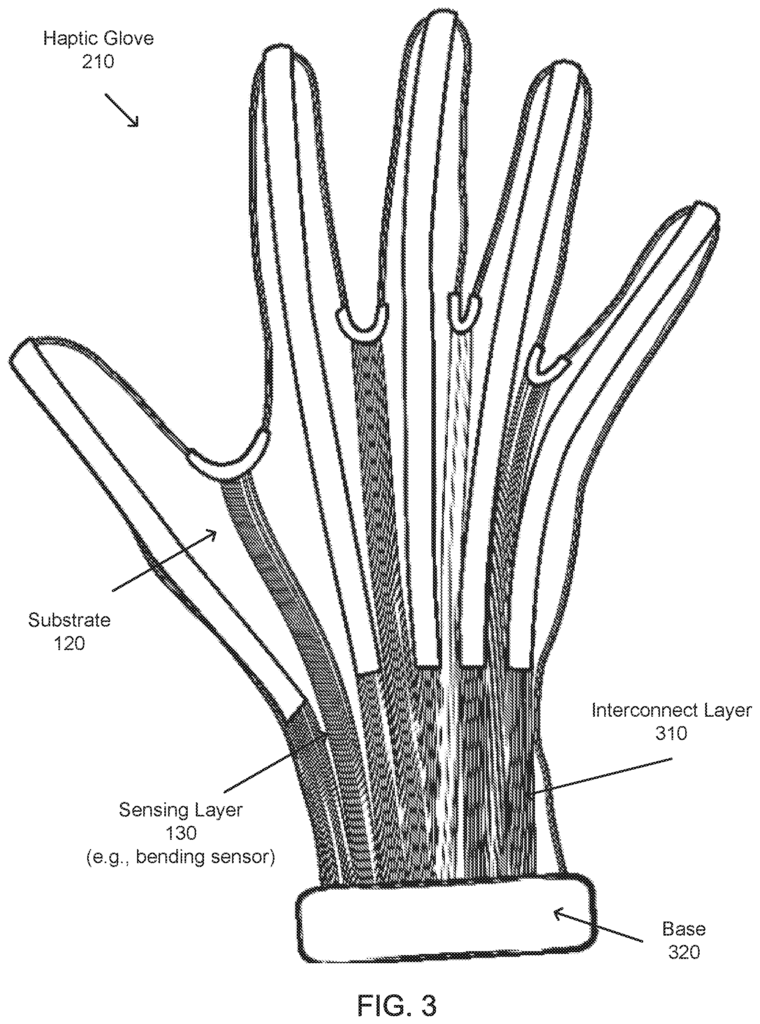
The design rules may specify the propagation delay for the system. The propagation time is the amount of time it takes for a particular signal to travel through the system. The propagation delay here is defined as an end-to-end delay for a VR/AR/MR components, such as a glove. The propagation delay is the maximum time that a fluid or signal from the one end of the component, (e.g. the glove base), should take to reach the opposite end (e.g. a finger), within a specified value. In order to maintain the propagation time, the propagation design rule affects multiple secondary rules, characteristics, and components. The design rules could, for example, specify that gain components are used at specific intervals on a circuit in order to increase the flow of fluids to reduce propagation delays. To reduce their response time, actuators and other components can be specified with maximum capacitances. It may be necessary to design the actuators with a lower fluid capacity.
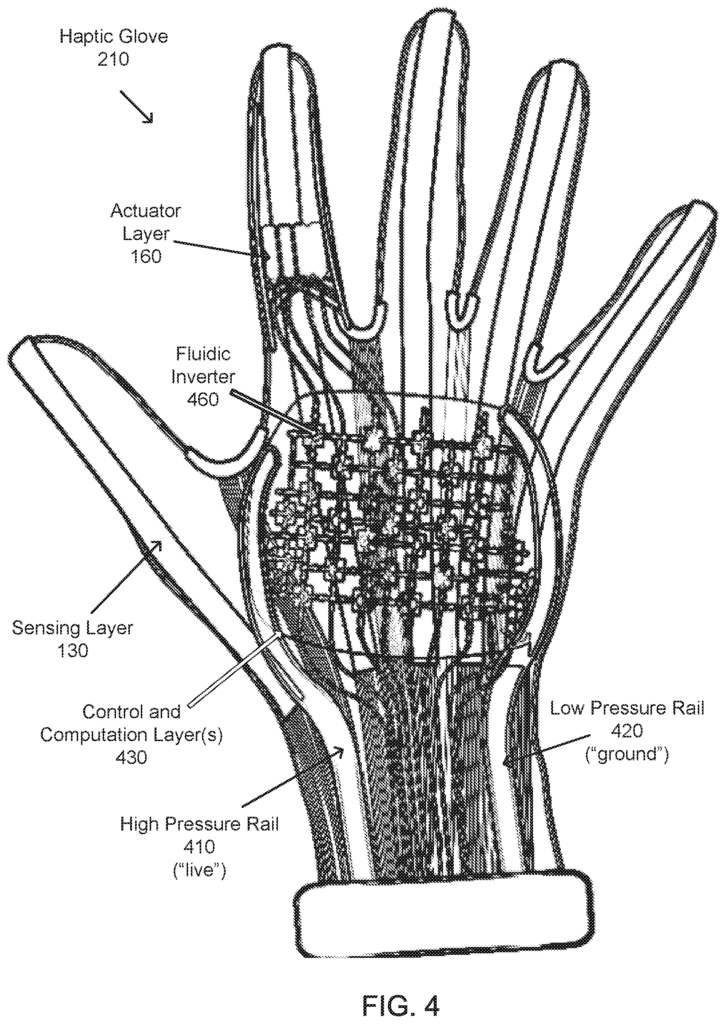
Click here to view the patent on Google Patents.
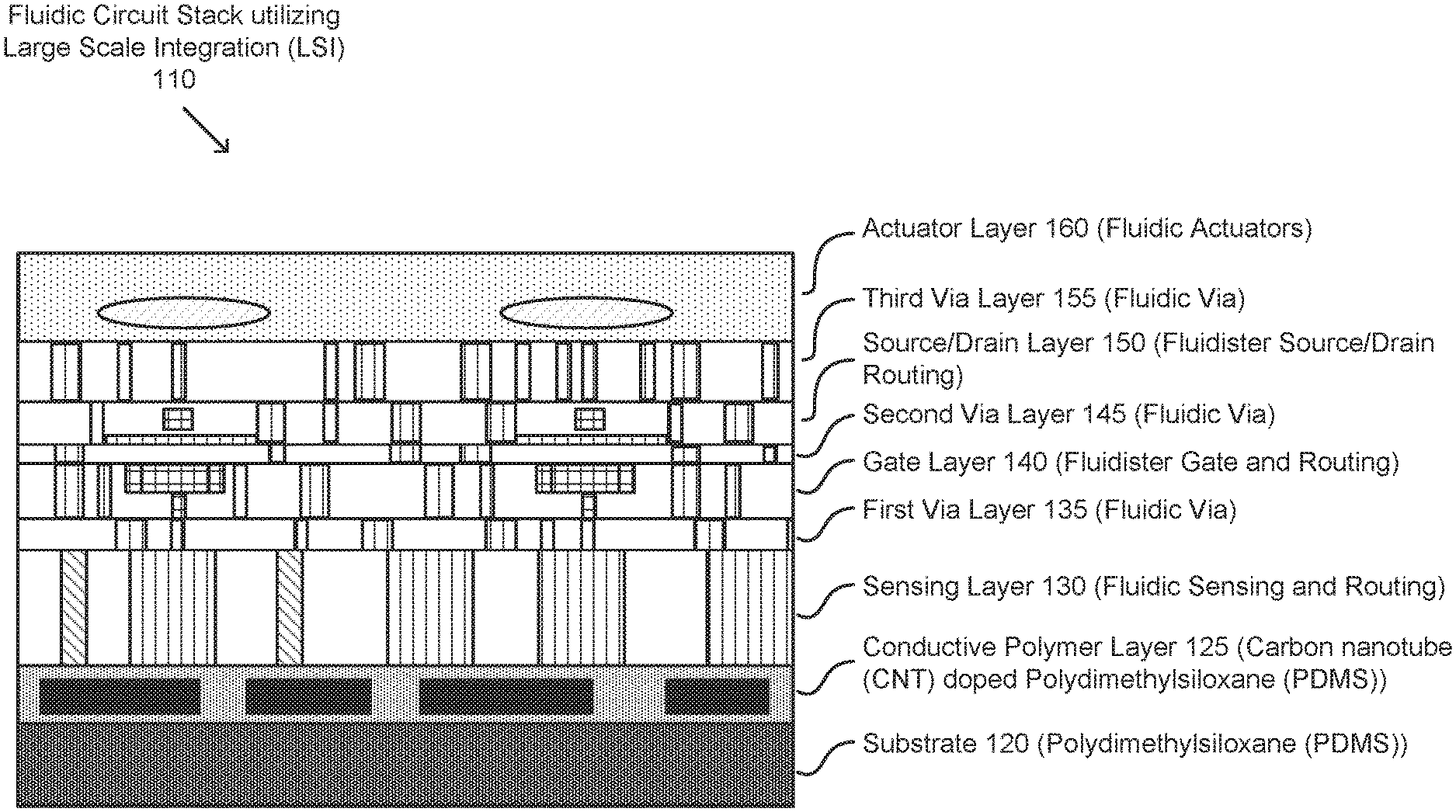
Leave a Reply